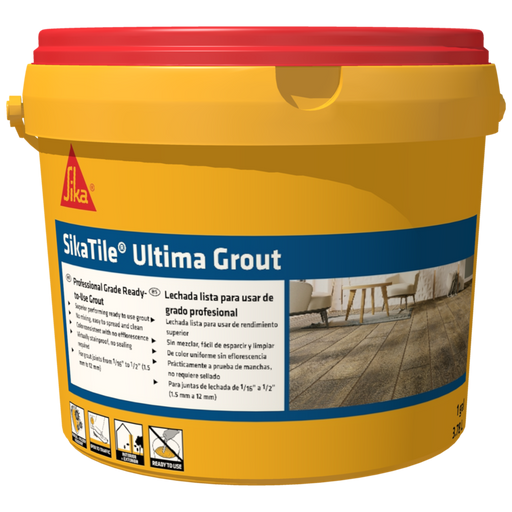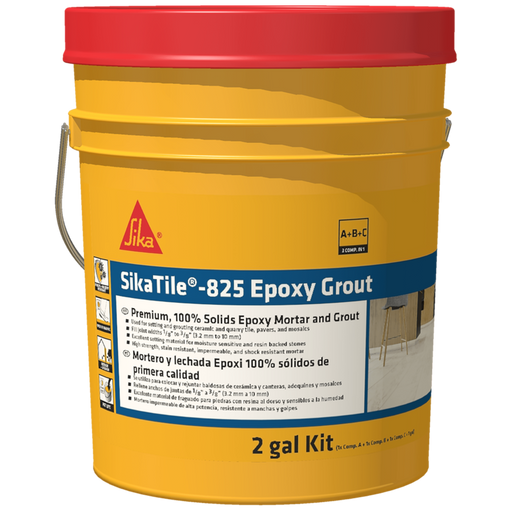Grouts
Filters
-
 Sale
Sale

SikaTile®-850 Ultima Grout
SikaNo reviews$57.09| /Professional Grade Ready-To-Use Grout SikaTile®-Ultima Grout is a professional-grade, ready-to-use grout designed for commercial and residentia...
View full details -
 Sale
Sale

SikaTile®-825 Epoxy Grout
Sika2 reviews$119.00| /100% Solids Epoxy Mortar and Grout SikaTile®-825 Epoxy Grout is a premium, Epoxy Grout and Mortar with Colored Quartz. It is a three-component, ...
View full details -
 Sale
Sale

ColorSil Sanded 100% Silicone Caulk (SIKA Grout Color Matches)
Color Rite Inc.No reviews$25.00| /Color Sil is designed for sealing applications exposed to high moisture areas inside or out! Color Sil is ideal for sealing around bathroom fixture...
View full details -
 Sale
Sale

SikaTile 880 Sanded Caulk
SikaNo reviews$9.99| /SikaTile®-880 Sanded Caulk is a premium-grade, one-part, siliconized, acrylic-based caulking compound that is easy-to-use, easy-to-clean, and mold ...
View full details
The Best Grout Accessories
Grout is a crucial component of tile and stone installations, despite being frequently disregarded. Grout adds a great deal to the project's lifespan and aesthetic appeal in addition to serving the practical functions of sealing joints and holding tiles in place. Choosing the best grout for your installation can be intimidating due to the abundance of options on the market.
It is important to understand the significance of this material, which is sometimes overlooked, before getting into the nuances of grout selection and application. Grout improves the installation's overall appearance in addition to filling in the spaces between the tiles, which supports the structure and keeps it from moving. You can improve the visual attractiveness of your room by blending tiles seamlessly or creating a statement with contrasting colors by selecting the appropriate grout color and formulation.
There are numerous formulations of grouts available, each one designed to meet the demands of different applications, climates, and aesthetic tastes. To choose the best grout for your job, it is crucial to comprehend how different kinds differ from one another.
Knowing the Different Grouts
Cement, sand, and additives are combined to create cement-based grouts, which are the most popular kind. Cement-based grouts come in both sanded and unsanded versions and are ideal for a variety of tile applications, such as floors, walls, and worktops. For joints larger than 1/8 inch, sanded grouts are suggested because they offer more strength and longevity; on the other hand, unsanded grouts work best for small joints and fragile tile materials like marble or glass.
Made of epoxy resins and hardeners, epoxy grouts provide exceptional strength, durability, and stain, chemical, and moisture resistance. These groups are especially well-suited for commercial installations, high-traffic areas, and water-prone settings like kitchens and bathrooms. Although epoxy grouts are more costly and difficult to work with than cement-based grouts, they are nonetheless a wise investment for demanding applications due to their remarkable performance and longevity.
Premixed grouts, as the name implies, require no mixing or additional ingredients; they are ready to use right out of the bottle. These grouts are useful for do-it-yourselfers who want an easy installation process or for small-scale tasks. Premixed grouts are more appropriate for less demanding applications because they might not provide the same degree of durability or color consistency as typical cement-based or epoxy grouts.
Although grout may not seem like much in the great scheme of tile and stone installations, its influence on the final result of your project is significant. You may attain flawless outcomes that improve the aesthetic appeal, robustness, and lifespan of your installations by being aware of the various grout types that are available, taking important variables into account throughout the selection process, and adhering to recommended application and maintenance procedures.





